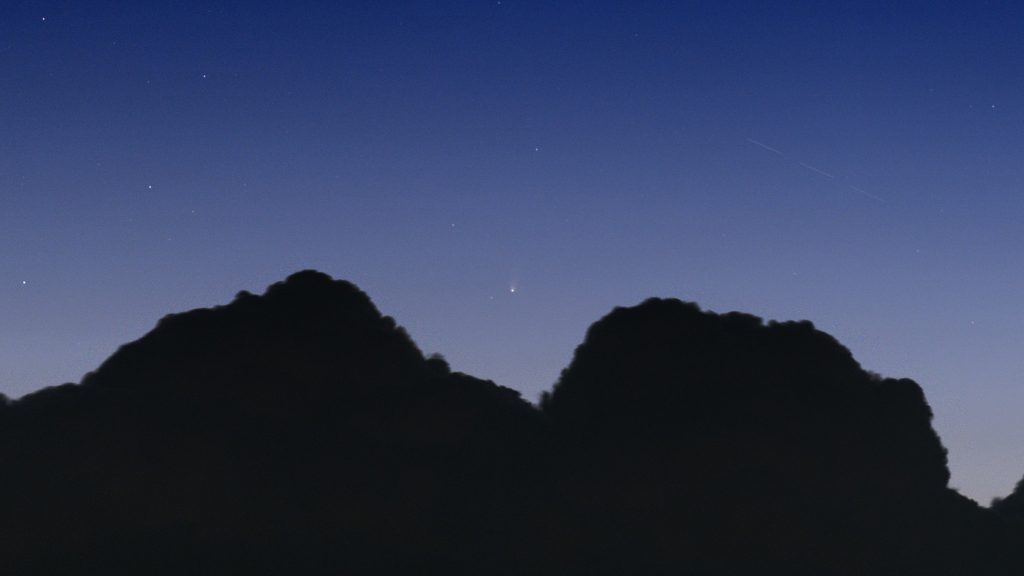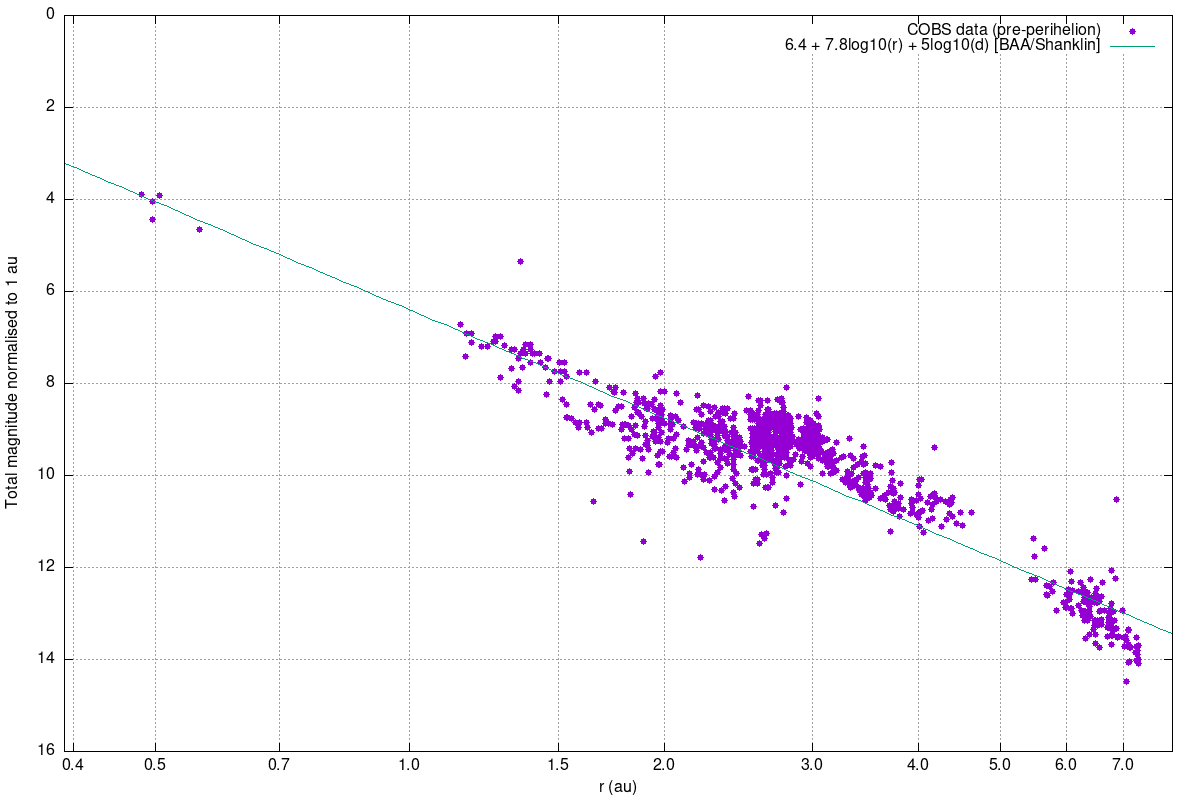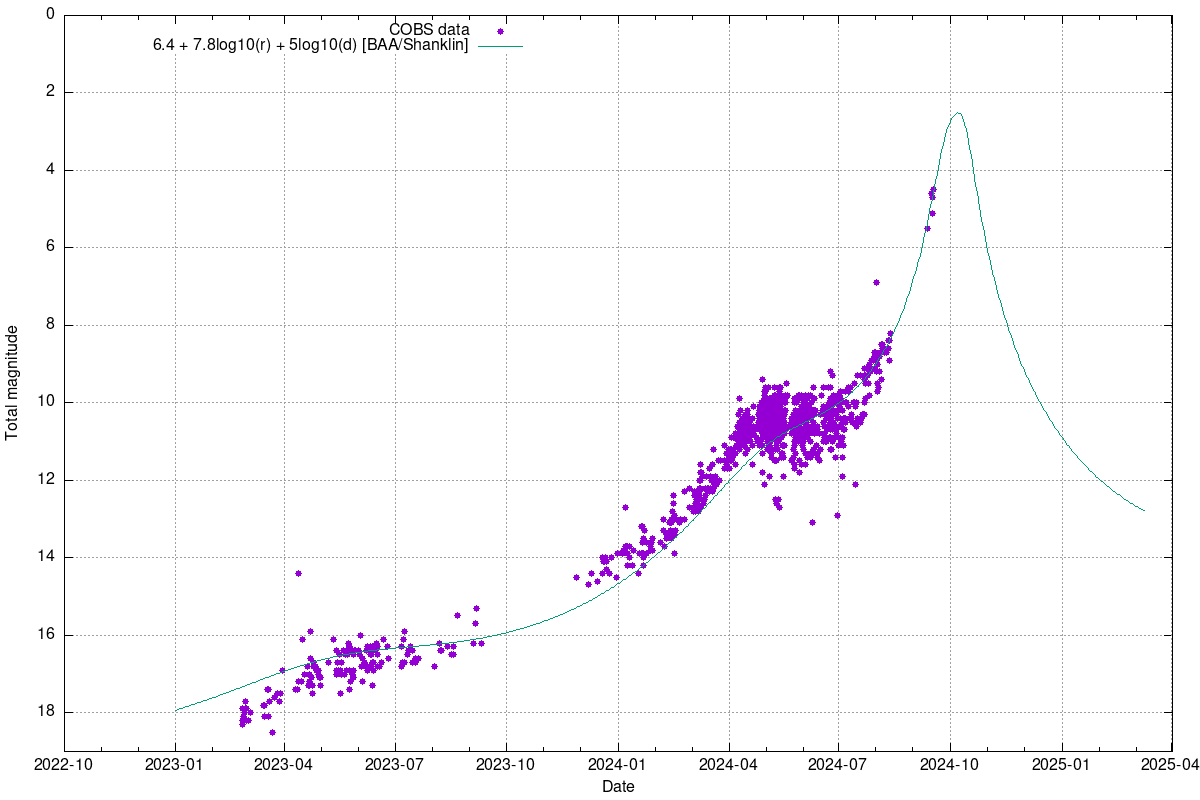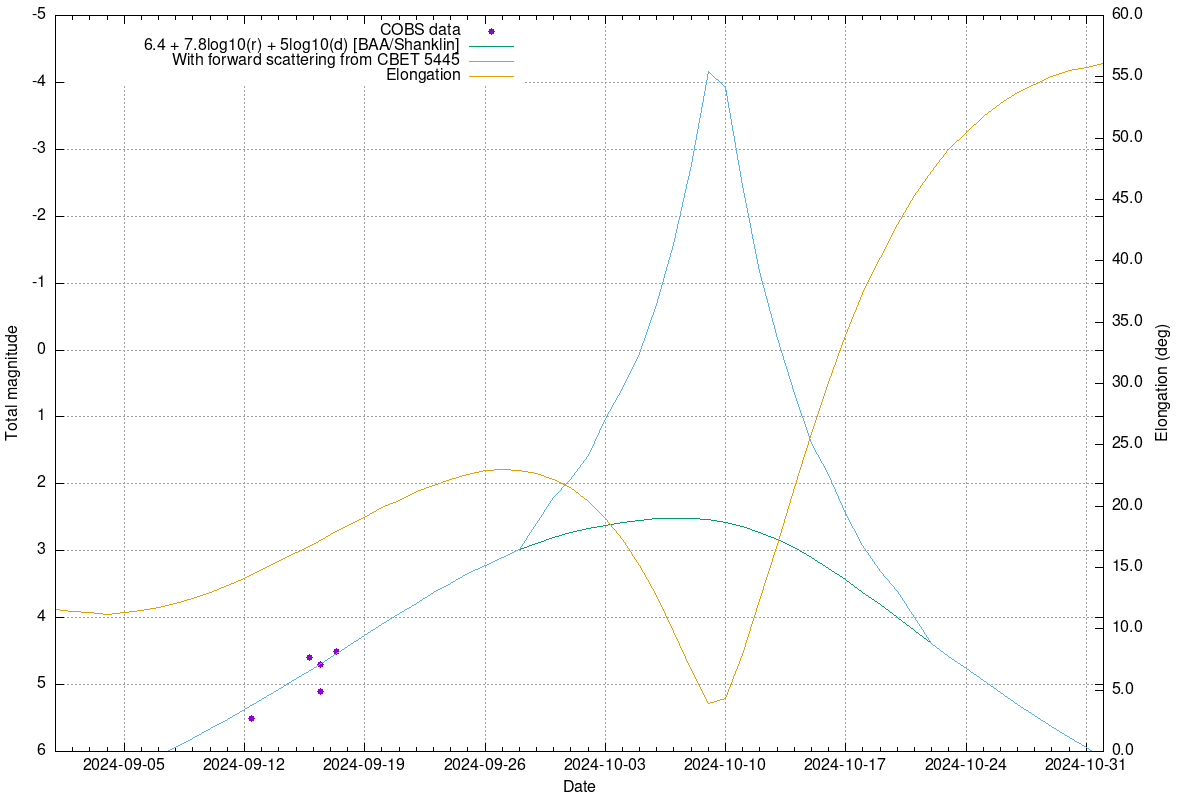2024 September 17
Comet C/2023 A3 Tsuchinshan-ATLAS looking good for October
It is always dangerous to count cometary chickens before they are hatched but it really does look as if we will have a nice comet in the evening sky in the middle of October. The comet was lost in the evening twilight in mid August as it approached the Sun but it has now emerged into the morning sky and recent observations from the southern hemisphere have shown that this comet is still very much alive.

C/2023 A3 was discovered in 2023 January and it comes to perihelion on September 27 when it will be only 0.39 au from the Sun (about the mean distance of Mercury). After perihelion it reaches solar conjunction on October 9 when the elongation is only 4 degrees and then makes its closest approach to the Earth on October 12 when it will be 0.47 au away in the constellation of Virgo. At its brightest the comet will be low in a twilight sky. From the UK there is a small chance of seeing it pre-conjunction in the morning but the best views will probably be had post-conjunction. There is a possibility that the comet will be at a negative magnitude as it emerges into the evening sky from October 10 onwards.
The magnitude of a comet is generally given by the formula m1 = H + 2.5 G log10(r) + 5 log10(d) where r and d are the distance from the Sun and Earth in au, H is the magnitude the comet would have if it was 1au from both the Earth and the Sun and G is a parameter which tells us how much more quickly the comet brightens as it approaches the Sun compared to an inert rocky object. If we plot the observed magnitudes (m1) against log10(r) we should be able to determine H and G by fitting a straight line to the points. This plot is an example of that and it uses data from COBS up to 2024 September 17. The points at small values of r were obtained recently from the southern hemisphere. The best fit straight line has an intercept at 1 au of 6.4, this corresponds to H, and a a slope of 7.8 which corresponds to 2.5G so G is 3.1.

We can now use these parameters to predict the comet’s brightness since we know how r and d change with time. This plot shows the same points as before, but this time we plot m1 against the date. The curve predicts a sharp brightening with a peak magnitude of around 2.5 around October 7. The current expected error at peak brightness is around +/- 0.5 magnitudes.

We may be in for a much brighter comet than predicted by this simple model. The viewing geometry post-perihelion is very likely to lead to a significant brightening due to forward scattering from dust particles in the coma. The scattering angle reaches a minimum of 7 degrees on October 9 and Joe Marcus predicts that this could increase the comet’s brightness by 7 magnitudes! Details are in CBET 5445 and the magnitude prediction with this model of forward scattering is shown in the next plot. It is possible that the comet could reach magnitude -4 on October 9 but at this time the solar elongation is only 4 degrees. The elongation increases rapidly after October 9 but the effect of forward scattering quickly reduces although the comet could still be very bright on the evenings of October 10 and 11 when it might be visible just after sunset if the sky is very clear. Some people with the right equipment and sky conditions may even detect it in the daylight sky but this should only be attempted if you know what you are doing since the Sun will be very close by and this is potentially a very dangerous observation, similar to observing Venus at inferior conjunction.

Another key date is October 14. On this day the Earth passes through the comet’s orbital plane and so the dust tail will be seen edge-on and its brightness should be significantly enhanced. The situation is shown in the following plot. We saw an example of this recently with comet C/2022 E3 (ZTF) but one of the best examples was C/2011 L4 (PanSTARRS) on 2013 May 26. Simulations of the likely tail and anti-tail appearance are here. The comet could look very similar to the famous comet C/1956 R1 (Arend-Roland) around this time. This image by Dr. Reggie Waterfield taken on 1957 April 27 shows the view we might have.

The visibility of the comet in the morning and evening skies from now until late October is shown in the following two plots. These show the elevation of the comet above a sea horizon for various latitudes when the Sun is 6 degrees down, i.e. the end of civil twilight. Bear in mind that the twilight sky near the horizon will still be very bright at this time and, unless the comet is very bright, you will probably need to wait until the Sun is 9-12 degrees down in practice. Every degree further that the Sun is down means roughly one degree less altitude for the comet. At present (mid-September) the comet is visible low in the morning sky from the Southern hemisphere. The optimum latitude is between 10 and 30 degrees south. From 50N there is a possibility that the comet might be visible towards the end of September but this would be a very challenging observation and it would require a very good horizon and very transparent skies to the east.
After perihelion the comet rapidly disappears from the morning sky and reaches conjunction with the Sun on October 9 when it has an elongation of only 4 degrees. This is the date of the maximum forward scattering magnitude enhancement. When the comet appears in the evening sky the northern hemisphere is favoured and the best latitudes are between 10 and 50 degrees N although the comet rapidly becomes visible at all latitudes other than the far south. The comet may be brighter than 2nd magnitude through to the 17th and should have an impressive tail. We have to hope that the weather will cooperate! The Moon is at first quarter on October 10th but should not be a problem while the comet is visible in the twilight. It will start interfering later as the comet moves into darker skies and it reaches full on October 17. At this time of year it lingers in the evening sky until well past full so it will continue to be a problem as the comet fades but late October will provide an opportunity to image a good telescopic comet relatively high in a dark sky.
All of this is currently speculation based on good evidence and comets can disappoint but it is worth taking every opportunity of clear weather in case it does perform. The nucleus is quite large, probably > 2km, so the comet will almost certainly survive perihelion so there will be something there to observe in October whatever happens! If you can plan to get to somewhere with a very good western horizon and very clear skies on the evenings of October 11-14 you may well be rewarded with a very impressive comet. Alternatively, you might not be…
To keep up to date with images of the comet have a look at the section archive here.


| The British Astronomical Association supports amateur astronomers around the UK and the rest of the world. Find out more about the BAA or join us. |
